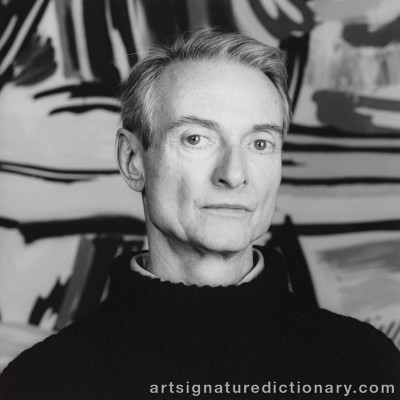
Roy LICHTENSTEIN
1923–1997, USA
Biography
Discover the life and artistic journey of Roy LICHTENSTEIN (born 1923, USA, died 1997), including key biographical details that provide essential context for signature authentication and artwork verification. Understanding an artist's background, artistic periods, and career timeline is crucial for distinguishing authentic signatures from forgeries.
Roy Lichtenstein is a pop art painter whose works, in a style derived from comic strips, portray the trivialization of culture endemic in contemporary American life. Using bright, strident colors and techniques borrowed from the printing industry, he ironically incorporates mass-produced emotions and objects into highly sophisticated references to art history.
Born in New York City in 1923, Lichtenstein studied briefly at the Art Students League, then enrolled at Ohio State University. After serving in the army from 1943 to 1946, he returned to Ohio State to get a master's degree and to teach.
Tn 1951, Lichtenstein came back to New York City and had his first one-man show. He also continued to teach, first at the New York State College of Education at Oswego, and later at Douglass College, a division of Rutgers University in New Jersey.
Through the 1950s, Lichtenstein used the basic techniques of abstract expressionism, but incorporated into his compositions such themes as cowboys and Indians and paper money. In 1961, however, while at Douglass College, impressed by the work of colleague Allan Kaprow, he turned to the use of comic-strip and cartoon figures by which he is known today. Flatten... sandfleas (1962, Museum of Modern Art) was the first important example of his new style.
Primary colors--red, yellow and blue, heavily outlined in black--became his favorites. Occasionally he used green. Instead of shades of color, he used the benday dot, a method by which an image is created, and its density of tone modulated in printing. Sometimes he selected a comic-strip scene, recomposed it, projected it onto his canvas and stenciled in the dots. "I want my painting to look as if it had been programmed," Lichtenstein explained.
Despite the fact that many of his paintings are relatively small, Lichtenstein's method of handling his subject matter conveys a sense of monumental size. His images seem massive.
Since 1962, he has turned to the work of artists such as Picasso, Mondrian, and even Monet as inspiration for his work. In the mid-1960s, he also painted sunsets and landscapes in his by-nowfamiliar style. In addition, he has designed ceramic tableware and graphics for mass production.
"I'm interested in portraying a sort of antisensibility that pervades society," Lichtenstein says, summing up his work.
In 1967 his first museum retrospective exhibition was held at the Pasadena Art Museum in California. Also in this year his first solo exhibition in Europe was held at museums in Amsterdam, London, Bern and Hannover. He married his second wife, Dorothy Herzka in 1968.
In the 1970s and 1980s, his work began to loosen and expand on what he had done before. He produced a series of "Artists Studios" which incorporated elements of his previous work. A notable example being Artist's Studio, Look Mickey (1973, Walker Art Center, Minneapolis) which incorporates five other previous works, fitted into the scene.
In the late 1970s, this style was replaced with more surreal works such as Pow Wow (1979, Ludwig Forum für Internationale Kunst, Aachen). In 1977, he was commissioned by BMW to paint a Group 5 Racing Version of the BMW 320i for the third installment in the BMW Art Car Project. In addition to paintings, he also made sculptures in metal and plastic including some notable public sculptures such as Lamp in St. Mary’s, Georgia in 1978, and over 300 prints, mostly in screenprinting.
His painting Torpedo...Los! sold at Christie's for $5.5 million in 1989, a record sum at the time, making him one of only three living artists to have attracted such huge sums. In 1996 the National Gallery of Art in Washington, D.C. became the largest single repository of the artist's work when he donated 154 prints and 2 books. In total there are some 4,500 works thought to be in circulation.
He died of pneumonia in 1997 at New York University Medical Center.
Source: http://rogallery.com
Explore other artists
Discover other notable artists who were contemporaries of Roy LICHTENSTEIN. These artists worked during the same period, offering valuable insights into artistic movements, signature styles, and authentication practices. Exploring related artists makes it easier to recognize common characteristics and artistic conventions of their era.